|
|
Summary
Everybody wants to ‘grow their business’ these days, and we all know the feeling when things are picking up momentum - the phone starts ringing, people email saying they’re almost ready to buy etc.
But what is it that has created this effect in your business?
It is all the effort that you’ve put in over time that eventually starts to pay off.
And what happens if you stop putting effort in? Well, for a while you may still find people are getting in touch, but most often you’ll find everything slows down once more. Think about it in the context of advertising - as soon as you stop spending people stop seeing your ads, and in turn, stop getting in touch.
All this is very obvious, but what we’ve just done here is begin to introduce the concept of ‘the flyweel’...

This is a great ‘macro metaphor’ for your business, no matter what stage of growth journey you are on. You apply effort (force) and the business stores this energy, and keeps on turning.
But let’s go a step further. The flywheel may ‘turn’, but it is ‘momentum’ that you are really seeking - the more momentum, the more things are picking up pace.
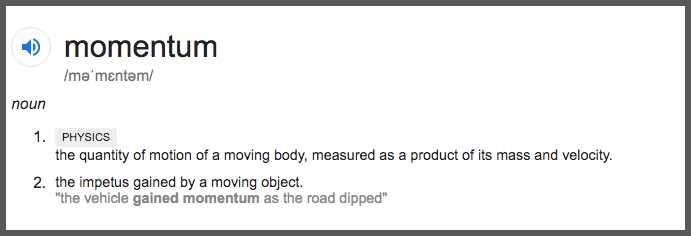
So, what causes your business to have momentum?
This is down to the ‘force’ that is applied.

In the case of business, this comes in the form of everything from time spent networking, to emails sent, to your spend on advertising. And, all being well, this will translate into adding more momentum to your flywheel.
But there is one more factor that needs to be considered…’friction’.

This is what will prevent the ‘force’ being turned into momentum. And much effort (force) is lost due to friction from a myriad of sources within your business. Friction is everywhere, and your job is to hunt out and reduce (or remove) its sources. We’ll talk more about this in the main text below.
In summary: Increase ‘force’; Reduce ‘friction’ and your business will build momentum. That’s it.
The real challenge is approaching how to do this in a methodological manner that delivers results as quickly as possible. That’s where we go next....
An Introduction to ‘GROW’
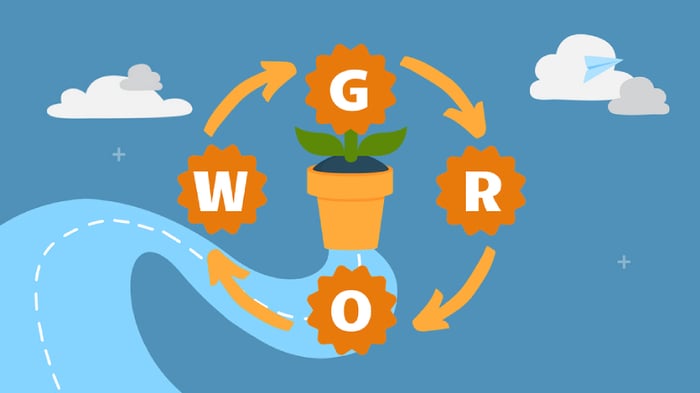
In every business there are conceptual models running wild, and whilst they serve a great purpose can often be outdated and counterproductive in your current circumstances.
For over 20 years I’ve been educating people in business using an array of models; and in the current world, with systems connecting to systems connecting to systems, we’ve needed to develop a new approach to show you how to overcome the challenges. As such, the first central model to run through is the Plus Your Business ‘GROW’ model.
This is what the letters stand for:
‘G’ stands for Goals
‘R’ stands for Resources
‘O’ stands for Organisation
‘W’ stands for Wins!
You can also see there is an ongoing process of movement from one stage to the next - generating energy in your flywheel.
Let’s run through all of the aspects, before we bring in a couple of additional familiar aspects...
Goals
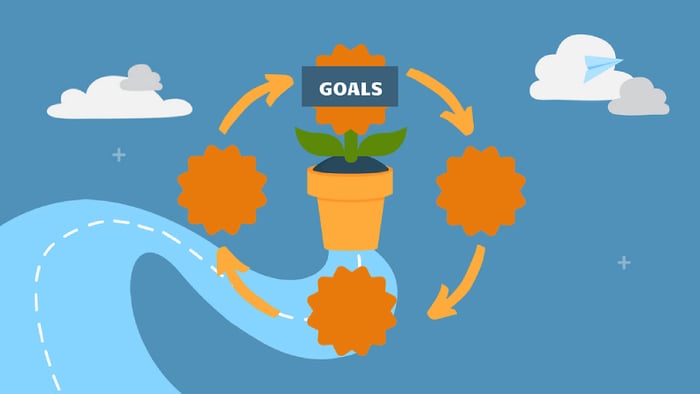
‘Intention’ is one of the most powerful tools you have that doesn’t cost you any money.
And we all know that setting goals are a central aspect of building and running a business.
I’ve put together a detailed approach to goal setting per marketing channel of your business here.
Let’s say you want to grow by 33% this next year - we next need to break this down into what this means re: leads and revenue.
Say your business is currently generating £1million in revenue, and you want to generate £1.33m
Take the uplift of £333k and do the following…
Think about the ‘average deal size’ - let’s say it is £10k, which means you need 33.3 new customers over and above what you are currently getting.*
Then, if we say 33 deals for the ease of math(s!), consider the following:
2000 leads > 200 Marketing Qualified Leads (MQLs) > 75 Sales Qualified Leads (SQLs) = 33 new customers*
*this has a few “it depends” included, but you get the gist.
This means you need to look to generate 2000 ‘leads’ or you may choose to focus on generating 200 MQLs more specifically.
If you want some suggestions on how to think about classifying leads, then check out this article.
Next, you will want to look at your available Resources to achieve these goals...
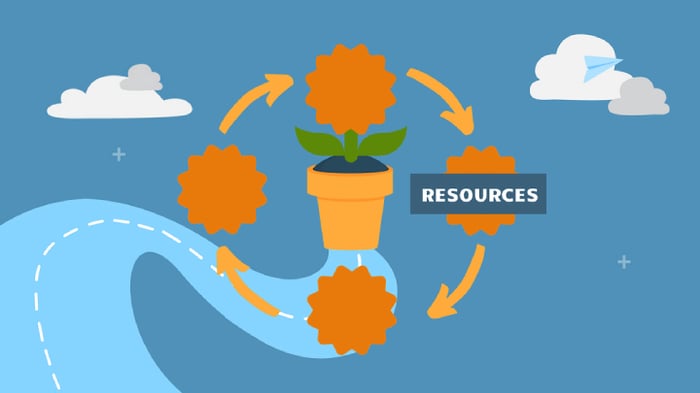
The people with who you work, the people you have in your network to connect with, your database of enquiries and customers, the money you spend on branding/advertising/conferences etc - all of these are your resources. As is every piece of written material that supports your products and services. Your business is already cram packed full of resources.
The challenge you have is how do you take this energy and best direct it in a way that generates the most force in your business.
Once you have resources in place, the force that is then applied comes down to a few factors:
Volume of activities
Clarity of intent (e.g. force being applied directly to your outcome)
Connectedness of action to result (e.g. speaking to a person’s needs)
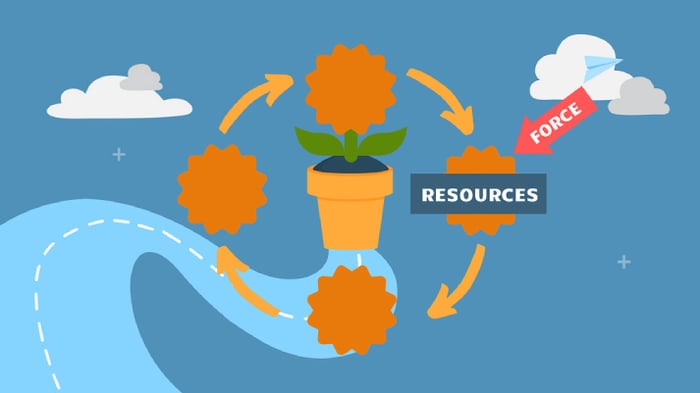
Think about this in terms of spinning your flywheel - it is all about turning that force into momentum.
You also need to have your focus on measuring the effectiveness of ‘that application of force’ via that resource each and every time.
In other words: Have one single metric you focus on for each ‘resource’ factor in your business.
For instance, for your sales team it may be ‘Deals on the Board’ based on a number of hours on phone and email; for your marketing team it may be number of SQLs generated, based on the MQLs that have been given to your sales team etc.
Then main thing is that you need to measure everything to know what deserves to be given more resources later on. We’ll get to that.
Note: when you are reviewing your resources in relation to your goals, there is probably a gap. In fact, there is almost always a gap. When you find the gap, the first question to ask is: can the gap be closed by re-organising current resources? If it can, then go for it.
If not, you will need to invest beyond your current efforts, which could be personal investment of time or money or both.
Now, it would be great if all your force turned into momentum, but as we know, it is ‘friction’ that will prevent that happening:
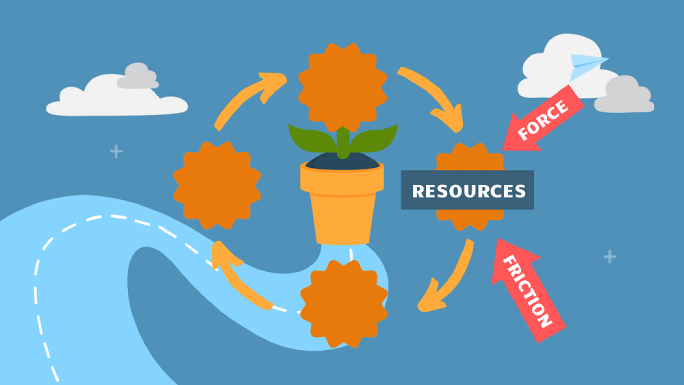
Friction comes in many forms, including:
- Systems ‘not talking to each other’ e.g. cutting and pasting data from spreadsheet to spreadsheet
- Manual tasks being repeated over and over
- Staff training and up-skilling on additional platforms
- Clunky website design; slow load speed
- Arduous form filling on website
- Confusing pricing
- Inconsistent messaging between different team members
- Clunky sales process and follow up
- Poor data input into your CRM, etc
And it is friction that puts the brakes on...
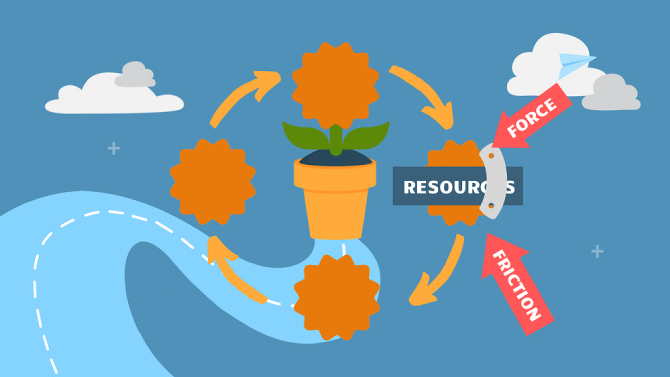
So, what you want to do is this:
- search out the friction points that prevent the most force being converted to momentum, and
- look to reduce, if not remove, as much friction as you can from each of those points.
The reduction of your top 10 friction points can, and probably will, solve most of the issues for your first round of ‘GROW’; you can then return to the next ones, but you’ll probably find you’ve developed a few more by then too.
One thing that will help you ascertain your friction points is to map out you user journey - here is a blog that will help you with that.
And once you’ve done that, you’ll want to know how to segment your CRM to help move people more easily from stage to stage.
Next, we move into the CENTRAL principle of the GROW process: it is through better ORGANISATION that you will transform the most force, and reduce the most friction...
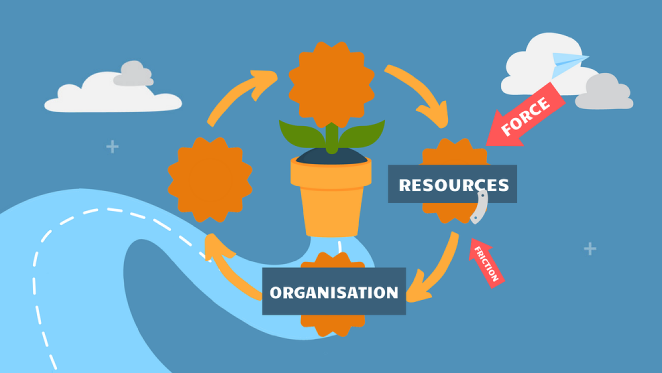
The antidote to complexity is not to make everything simple, but to create ‘organisation’.
Or, if you’d prefer:
‘Organisation’ is the antidote to complexity.
Create better ‘organisation’ throughout your business and you will be able to turn more of that force into momentum.
To begin, look to organise your current resources in a way that improves efficiency.
This includes:
- ‘naming conventions’ throughout the business (for lists, for workflows, for ‘image’ names)
- using consistent templates for emails,
- automating repeatable processes,
- automating sales management reports,
- and so on.
This is what we do for our clients - put in place the systems, and structures/flows/processes that deliver sustainable business growth.
It really depends on what systems you are using as to how best you approach this, but inevitably you need one person to set the rules for others to follow. To help with this, you need a policy document to guide behaviours. It doesn’t need to be more than a few pages long for each business area. You’ll see an example of a 30 point sales charter I put together here that gave structure to a client’s business.
In addition (but really, before you begin) you’ll need to consider how your systems are connected to each other. This is a horror story for most businesses, with 10s of applications holding data about different aspects of a customer’s activity and experience with you. We’ll come back to this at the end, and I’ll offer a solution…
Next, look at the ‘Wins!’ in your business.

This is not only about ‘customers’ and ‘revenue’ as those are later stage indicators of whether something is working. Even on Day 1 of a business bringing on a new product or service you can have ‘wins’ without sales.
You remember the ‘single metric’ I mentioned? Well, one of the early stage metrics for a sales team can be ‘clicks on links’ to your website via emails they send to prospects.
Download HubSpot’s CRM and link your Inbox to get this functionality or I can set you up FREE here!

The main thing to do at this stage though is look at where the ‘wins’ are coming from i.e. which resources, what effort, which application of ‘force’ is generating the wins. This is what you will want to resource more.
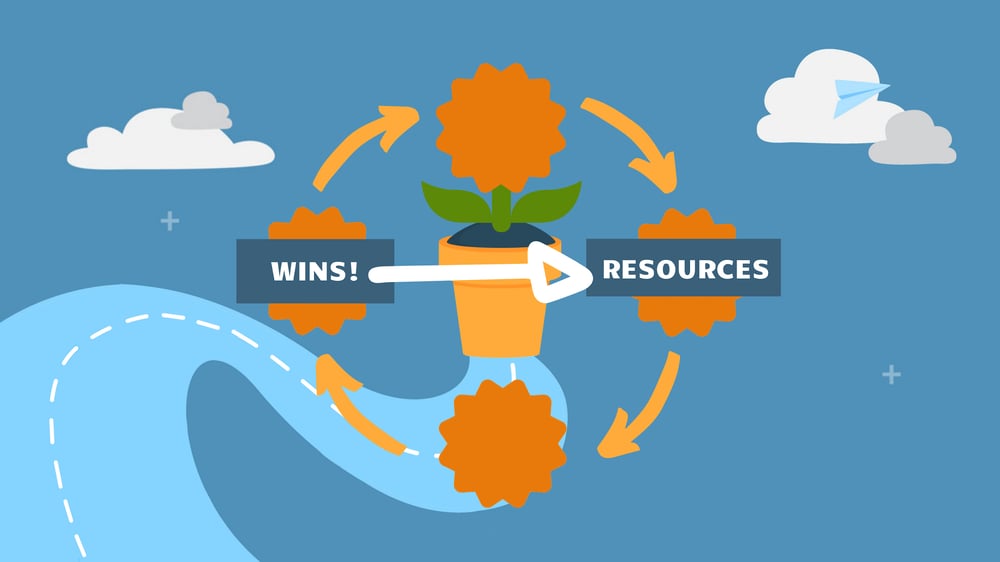
Of course, how connected your business is between the ‘wins’ you are measuring and the resources you’ve deployed (and how well organised you are at ‘granularly measuring’ them) will determine the insight you gain.
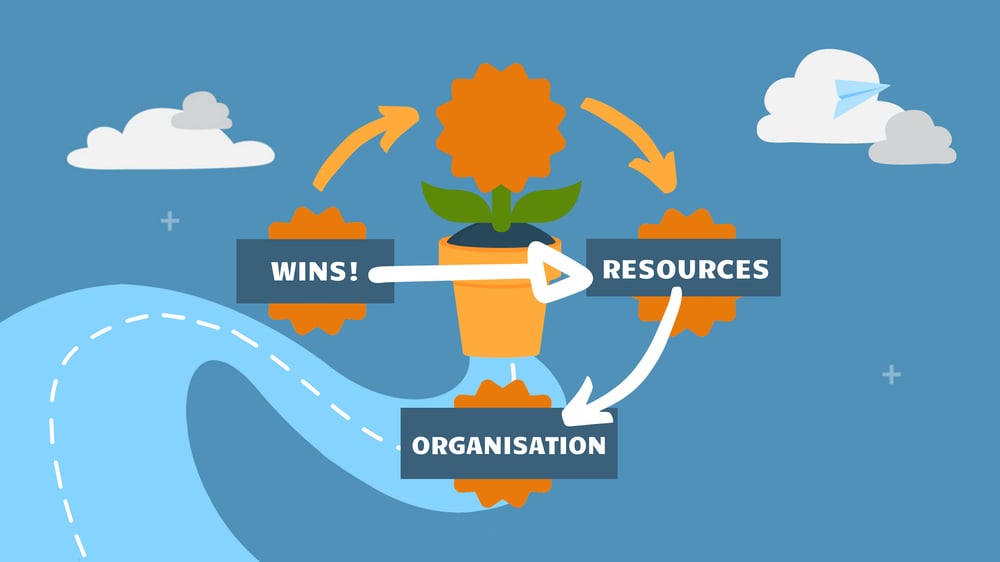
Once you have an integrated systems approach to your resource allocation, you will then be able to reallocate the force more effectively - adjusting how your business is organised in order to generate more wins.
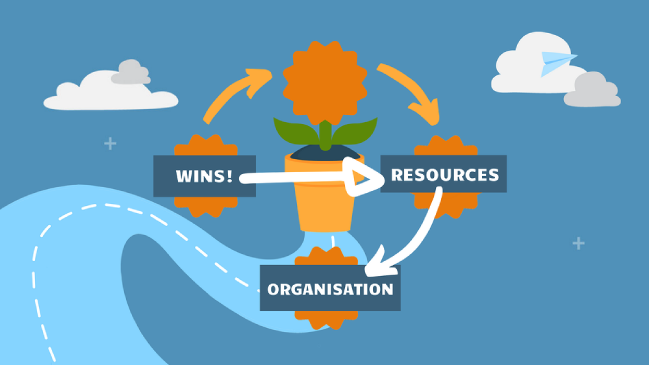
This is where we take the next leap in the process and introduce ‘The Optimisation Loop’:
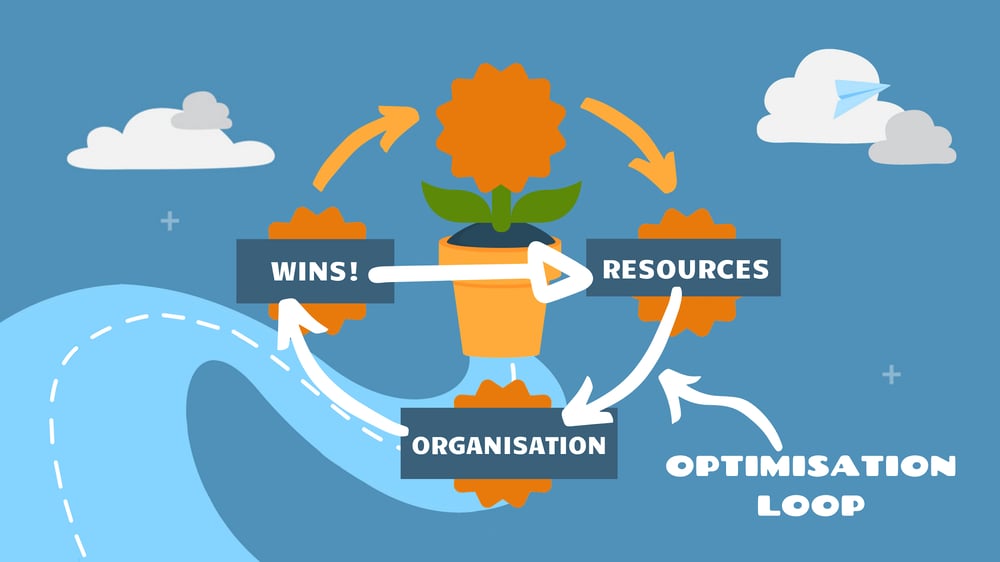
So what is ‘The Optimisation Loop’?
‘The Optimisation Loop’ is an ongoing interrogation, driven by insights gained through organised processes within a connected system, as to ‘what’s working’ and what’s not.
Take the example of your spend on Google Adwords.
Unless you are an ecommerce site, I bet you CANNOT tell which campaigns (let alone keywords) are generating leads that are converting into customers. The reason why is simple - your CRM is not connected to your Adwords account and email marketing system, all in one.
If it is, you’ve cracked a piece of the puzzle - you need your customer data all in one place. Without this, you are allocating resources e.g. Ads, without being able to truly measure their effectiveness.
Here is a blog on why I am obsessed with this area of spend attribution.
This is not just about Adspend though. To understand the breadth of the process, let’s look at what ‘Optimisation’ (as is spelt in British English) means...

This idea of ‘making the best of’ is probably quite different to the subtle percentage signs that many people have in their heads - e.g. increasing profit by 15%, or a conversion rate on a landing page by 20%
But really, optimisation is much broader - and in our model we include people’s attitudes and behaviours as well as systems.
There are literally hundreds of factors you can consider and then adjust an array of variables in order to make improvements in your business. Here are just a few…
- Increasing the volume of calls/emails made by your sales team, using technology to do so
- Increasing number of opens and clicks of sales and marketing emails through testing and adjusting the templates
- Improving conversion rates on your webforms, landing pages or ads through A/B testing
- Increasing conversion between lifecycle stages by A/B testing emails and sales scripts
- Improving ratings in customer feedback and overall satisfaction
- Improving referral rates from customers
- Improving staff retention
- Reducing ‘waste’ within the business
- Decreasing time spent in meetings, and still achieving results
- Decreasing ‘Deal Stage’ stagnation
- Improving Life Time Value of customers
- And so on.
The question is, how can you automate as much of this process as possible? Without automation you will always be chasing your tail, trying to figure out what changes will make a difference.
Good news is, there is a solution.
Finally...
We’ve reached the end of the Introduction to GROW and hopefully you’ve begun to see how this straightforward model can be installed into your own business. When you do, you will be able to drive further ahead towards your goals.
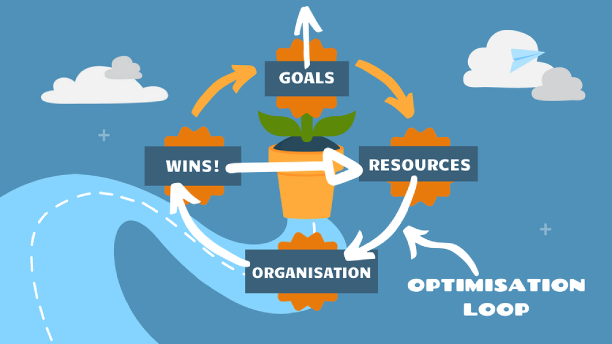
The reality is though, you will find it very challenging to undertake effective Organisation and Optimisation without installing the right technology for the job. I’ve been very intentional not to ‘push HubSpot’ throughout this section, but the reality is...you will find it almost impossible to effect and measure effective change without a centralised database of customer activity. Once you have this, you want to look at AUTOMATING as much of the workload as possible. This is the way to think about getting HubSpot in your business - free has no automation, starter has a tiny amount, then PRO brings in automation, before Enterprise brings greater intelligence to that automation.
Next steps:
The good news is, we’re here to help install the right solution for you, and have an approach that enables deployment of a series of automated processes ‘right out of the box’. To find out more, please do get in touch with us here or call 02920 290 561 (international +44 2920 290 561)
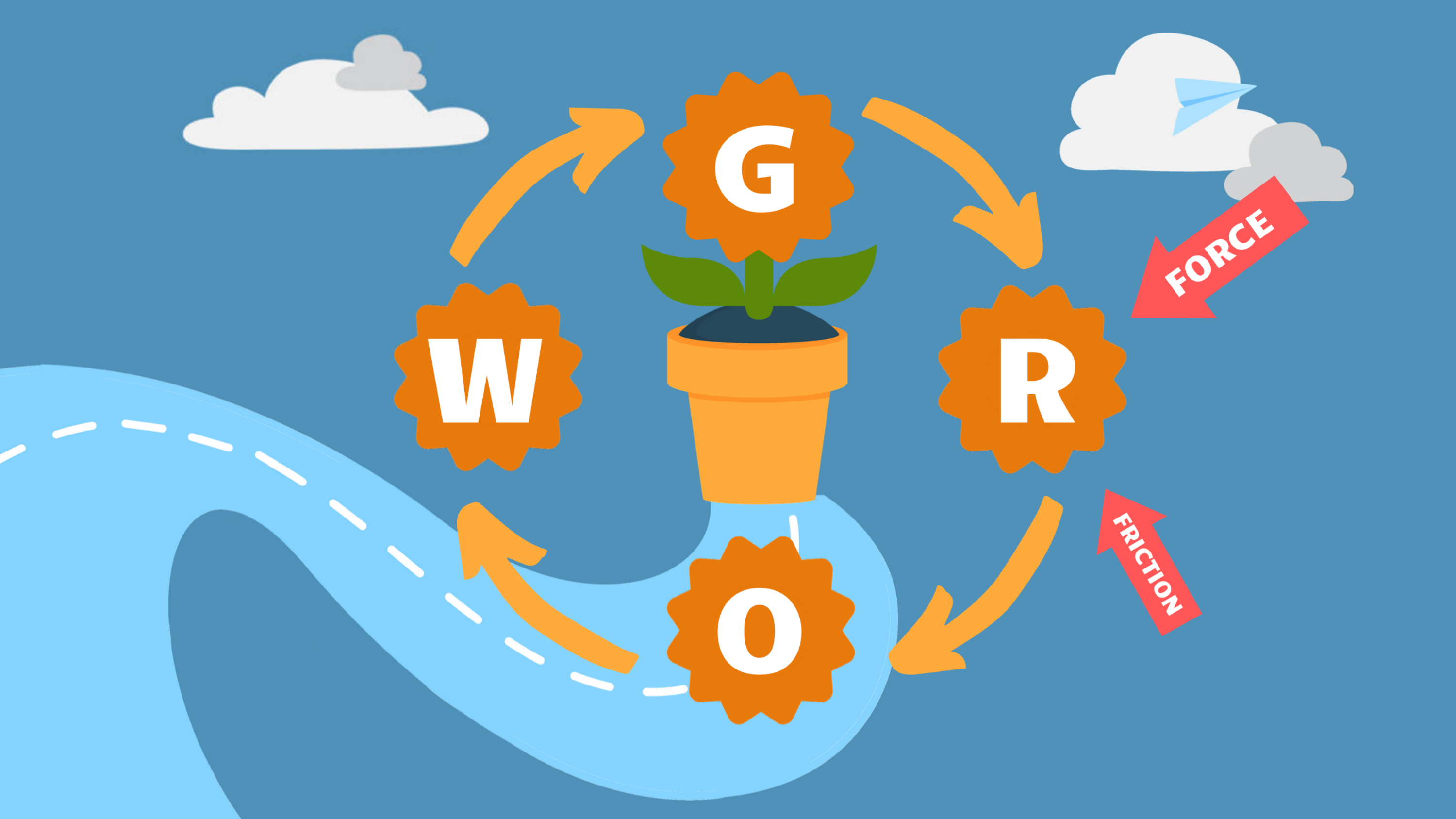
|
|
Summary
Everybody wants to ‘grow their business’ these days, and we all know the feeling when things are picking up momentum - the phone starts ringing, people email saying they’re almost ready to buy etc.
But what is it that has created this effect in your business?
It is all the effort that you’ve put in over time that eventually starts to pay off.
And what happens if you stop putting effort in? Well, for a while you may still find people are getting in touch, but most often you’ll find everything slows down once more. Think about it in the context of advertising - as soon as you stop spending people stop seeing your ads, and in turn, stop getting in touch.
All this is very obvious, but what we’ve just done here is begin to introduce the concept of ‘the flyweel’...

This is a great ‘macro metaphor’ for your business, no matter what stage of growth journey you are on. You apply effort (force) and the business stores this energy, and keeps on turning.
But let’s go a step further. The flywheel may ‘turn’, but it is ‘momentum’ that you are really seeking - the more momentum, the more things are picking up pace.

So, what causes your business to have momentum?
This is down to the ‘force’ that is applied.

In the case of business, this comes in the form of everything from time spent networking, to emails sent, to your spend on advertising. And, all being well, this will translate into adding more momentum to your flywheel.
But there is one more factor that needs to be considered…’friction’.

This is what will prevent the ‘force’ being turned into momentum. And much effort (force) is lost due to friction from a myriad of sources within your business. Friction is everywhere, and your job is to hunt out and reduce (or remove) its sources. We’ll talk more about this in the main text below.
In summary: Increase ‘force’; Reduce ‘friction’ and your business will build momentum. That’s it.
The real challenge is approaching how to do this in a methodological manner that delivers results as quickly as possible. That’s where we go next....
An Introduction to ‘GROW’

In every business there are conceptual models running wild, and whilst they serve a great purpose can often be outdated and counterproductive in your current circumstances.
For over 20 years I’ve been educating people in business using an array of models; and in the current world, with systems connecting to systems connecting to systems, we’ve needed to develop a new approach to show you how to overcome the challenges. As such, the first central model to run through is the Plus Your Business ‘GROW’ model.
This is what the letters stand for:
‘G’ stands for Goals
‘R’ stands for Resources
‘O’ stands for Organisation
‘W’ stands for Wins!
You can also see there is an ongoing process of movement from one stage to the next - generating energy in your flywheel.
Let’s run through all of the aspects, before we bring in a couple of additional familiar aspects...
Goals

‘Intention’ is one of the most powerful tools you have that doesn’t cost you any money.
And we all know that setting goals are a central aspect of building and running a business.
I’ve put together a detailed approach to goal setting per marketing channel of your business here.
Let’s say you want to grow by 33% this next year - we next need to break this down into what this means re: leads and revenue.
Say your business is currently generating £1million in revenue, and you want to generate £1.33m
Take the uplift of £333k and do the following…
Think about the ‘average deal size’ - let’s say it is £10k, which means you need 33.3 new customers over and above what you are currently getting.*
Then, if we say 33 deals for the ease of math(s!), consider the following:
2000 leads > 200 Marketing Qualified Leads (MQLs) > 75 Sales Qualified Leads (SQLs) = 33 new customers*
*this has a few “it depends” included, but you get the gist.
This means you need to look to generate 2000 ‘leads’ or you may choose to focus on generating 200 MQLs more specifically.
If you want some suggestions on how to think about classifying leads, then check out this article.
Next, you will want to look at your available Resources to achieve these goals...

The people with who you work, the people you have in your network to connect with, your database of enquiries and customers, the money you spend on branding/advertising/conferences etc - all of these are your resources. As is every piece of written material that supports your products and services. Your business is already cram packed full of resources.
The challenge you have is how do you take this energy and best direct it in a way that generates the most force in your business.
Once you have resources in place, the force that is then applied comes down to a few factors:
Volume of activities
Clarity of intent (e.g. force being applied directly to your outcome)
Connectedness of action to result (e.g. speaking to a person’s needs)

Think about this in terms of spinning your flywheel - it is all about turning that force into momentum.
You also need to have your focus on measuring the effectiveness of ‘that application of force’ via that resource each and every time.
In other words: Have one single metric you focus on for each ‘resource’ factor in your business.
For instance, for your sales team it may be ‘Deals on the Board’ based on a number of hours on phone and email; for your marketing team it may be number of SQLs generated, based on the MQLs that have been given to your sales team etc.
Then main thing is that you need to measure everything to know what deserves to be given more resources later on. We’ll get to that.
Note: when you are reviewing your resources in relation to your goals, there is probably a gap. In fact, there is almost always a gap. When you find the gap, the first question to ask is: can the gap be closed by re-organising current resources? If it can, then go for it.
If not, you will need to invest beyond your current efforts, which could be personal investment of time or money or both.
Now, it would be great if all your force turned into momentum, but as we know, it is ‘friction’ that will prevent that happening:

Friction comes in many forms, including:
- Systems ‘not talking to each other’ e.g. cutting and pasting data from spreadsheet to spreadsheet
- Manual tasks being repeated over and over
- Staff training and up-skilling on additional platforms
- Clunky website design; slow load speed
- Arduous form filling on website
- Confusing pricing
- Inconsistent messaging between different team members
- Clunky sales process and follow up
- Poor data input into your CRM, etc
And it is friction that puts the brakes on...

So, what you want to do is this:
- search out the friction points that prevent the most force being converted to momentum, and
- look to reduce, if not remove, as much friction as you can from each of those points.
The reduction of your top 10 friction points can, and probably will, solve most of the issues for your first round of ‘GROW’; you can then return to the next ones, but you’ll probably find you’ve developed a few more by then too.
One thing that will help you ascertain your friction points is to map out you user journey - here is a blog that will help you with that.
And once you’ve done that, you’ll want to know how to segment your CRM to help move people more easily from stage to stage.
Next, we move into the CENTRAL principle of the GROW process: it is through better ORGANISATION that you will transform the most force, and reduce the most friction...

The antidote to complexity is not to make everything simple, but to create ‘organisation’.
Or, if you’d prefer:
‘Organisation’ is the antidote to complexity.
Create better ‘organisation’ throughout your business and you will be able to turn more of that force into momentum.
To begin, look to organise your current resources in a way that improves efficiency.
This includes:
- ‘naming conventions’ throughout the business (for lists, for workflows, for ‘image’ names)
- using consistent templates for emails,
- automating repeatable processes,
- automating sales management reports,
- and so on.
This is what we do for our clients - put in place the systems, and structures/flows/processes that deliver sustainable business growth.
It really depends on what systems you are using as to how best you approach this, but inevitably you need one person to set the rules for others to follow. To help with this, you need a policy document to guide behaviours. It doesn’t need to be more than a few pages long for each business area. You’ll see an example of a 30 point sales charter I put together here that gave structure to a client’s business.
In addition (but really, before you begin) you’ll need to consider how your systems are connected to each other. This is a horror story for most businesses, with 10s of applications holding data about different aspects of a customer’s activity and experience with you. We’ll come back to this at the end, and I’ll offer a solution…
Next, look at the ‘Wins!’ in your business.

This is not only about ‘customers’ and ‘revenue’ as those are later stage indicators of whether something is working. Even on Day 1 of a business bringing on a new product or service you can have ‘wins’ without sales.
You remember the ‘single metric’ I mentioned? Well, one of the early stage metrics for a sales team can be ‘clicks on links’ to your website via emails they send to prospects.
Download HubSpot’s CRM and link your Inbox to get this functionality or I can set you up FREE here!

The main thing to do at this stage though is look at where the ‘wins’ are coming from i.e. which resources, what effort, which application of ‘force’ is generating the wins. This is what you will want to resource more.

Of course, how connected your business is between the ‘wins’ you are measuring and the resources you’ve deployed (and how well organised you are at ‘granularly measuring’ them) will determine the insight you gain.

Once you have an integrated systems approach to your resource allocation, you will then be able to reallocate the force more effectively - adjusting how your business is organised in order to generate more wins.

This is where we take the next leap in the process and introduce ‘The Optimisation Loop’:

So what is ‘The Optimisation Loop’?
‘The Optimisation Loop’ is an ongoing interrogation, driven by insights gained through organised processes within a connected system, as to ‘what’s working’ and what’s not.
Take the example of your spend on Google Adwords.
Unless you are an ecommerce site, I bet you CANNOT tell which campaigns (let alone keywords) are generating leads that are converting into customers. The reason why is simple - your CRM is not connected to your Adwords account and email marketing system, all in one.
If it is, you’ve cracked a piece of the puzzle - you need your customer data all in one place. Without this, you are allocating resources e.g. Ads, without being able to truly measure their effectiveness.
Here is a blog on why I am obsessed with this area of spend attribution.
This is not just about Adspend though. To understand the breadth of the process, let’s look at what ‘Optimisation’ (as is spelt in British English) means...

This idea of ‘making the best of’ is probably quite different to the subtle percentage signs that many people have in their heads - e.g. increasing profit by 15%, or a conversion rate on a landing page by 20%
But really, optimisation is much broader - and in our model we include people’s attitudes and behaviours as well as systems.
There are literally hundreds of factors you can consider and then adjust an array of variables in order to make improvements in your business. Here are just a few…
- Increasing the volume of calls/emails made by your sales team, using technology to do so
- Increasing number of opens and clicks of sales and marketing emails through testing and adjusting the templates
- Improving conversion rates on your webforms, landing pages or ads through A/B testing
- Increasing conversion between lifecycle stages by A/B testing emails and sales scripts
- Improving ratings in customer feedback and overall satisfaction
- Improving referral rates from customers
- Improving staff retention
- Reducing ‘waste’ within the business
- Decreasing time spent in meetings, and still achieving results
- Decreasing ‘Deal Stage’ stagnation
- Improving Life Time Value of customers
- And so on.
The question is, how can you automate as much of this process as possible? Without automation you will always be chasing your tail, trying to figure out what changes will make a difference.
Good news is, there is a solution.
Finally...
We’ve reached the end of the Introduction to GROW and hopefully you’ve begun to see how this straightforward model can be installed into your own business. When you do, you will be able to drive further ahead towards your goals.

The reality is though, you will find it very challenging to undertake effective Organisation and Optimisation without installing the right technology for the job. I’ve been very intentional not to ‘push HubSpot’ throughout this section, but the reality is...you will find it almost impossible to effect and measure effective change without a centralised database of customer activity. Once you have this, you want to look at AUTOMATING as much of the workload as possible. This is the way to think about getting HubSpot in your business - free has no automation, starter has a tiny amount, then PRO brings in automation, before Enterprise brings greater intelligence to that automation.
Next steps:
The good news is, we’re here to help install the right solution for you, and have an approach that enables deployment of a series of automated processes ‘right out of the box’. To find out more, please do get in touch with us here or call 02920 290 561 (international +44 2920 290 561)

